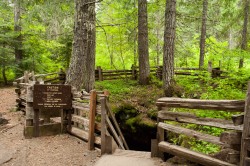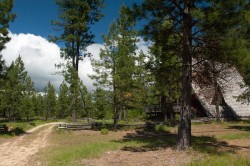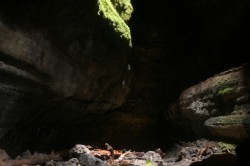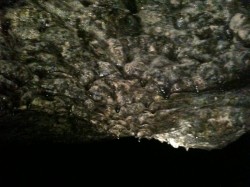 The forests that surround the volcanoes of the Pacific Northwest hide many lava tubes. In fact, due to the Federal Cave Protection Act and a human-spread bat pathogen, the NFS rangers will not disclose the location of most of these caves. Fortunately, the Guler Ice Caves are an exception, with a parking lot, restroom and stairway to the cave floor conveniently provided. Of all the lava tubes I’ve explored, these caves are, by far, the most impressive due to their intricate ice formations that last until early summer. Each year the ice melts and reforms into unique sculptures making the caves worthy of repeat visits. We arrived in June when most of the ice had melted, however we still found much to see and photograph. A signpost near the cave describes how it formed: [Read more…]
The forests that surround the volcanoes of the Pacific Northwest hide many lava tubes. In fact, due to the Federal Cave Protection Act and a human-spread bat pathogen, the NFS rangers will not disclose the location of most of these caves. Fortunately, the Guler Ice Caves are an exception, with a parking lot, restroom and stairway to the cave floor conveniently provided. Of all the lava tubes I’ve explored, these caves are, by far, the most impressive due to their intricate ice formations that last until early summer. Each year the ice melts and reforms into unique sculptures making the caves worthy of repeat visits. We arrived in June when most of the ice had melted, however we still found much to see and photograph. A signpost near the cave describes how it formed: [Read more…]
Inside the Guler Ice Caves of the Gifford Pinchot National Forest
Exploring the Trout Lake Cheese Caves
My wife and I do something adventurous to celebrate her June birthday every year. However, she was knee-deep in final exams this time. We decided to reschedule our adventurous outing for the weekend following her finals, when we could both relax and enjoy the experience. Having lived in Trout Lake, we heard about the many lava tubes in the area, including the well known ice caves and cheese caves. Sadly, we had neglected to take advantage of these sights in our own backyard until now.
 These caves have an interesting history as they were used as a natural refrigerator in the 1930s and 1940s due to their 42 degree year-round temperature. The Guler Cheese Company was founded at a time when aged French bleu cheese was in short supply due to the political turmoil preceding World War II. The goal was to replicate the aging process used to make Roquefort cheese, using caves for storage and aging. The Pacific Northwest Cheese Project has an article that covers the history of the site and it’s definitely worth a read. [Read more…]
These caves have an interesting history as they were used as a natural refrigerator in the 1930s and 1940s due to their 42 degree year-round temperature. The Guler Cheese Company was founded at a time when aged French bleu cheese was in short supply due to the political turmoil preceding World War II. The goal was to replicate the aging process used to make Roquefort cheese, using caves for storage and aging. The Pacific Northwest Cheese Project has an article that covers the history of the site and it’s definitely worth a read. [Read more…]
Exploring the Ape Cave on the Slopes of Mount St. Helens
For my wife’s birthday I took the day off work, arranged child care and gave her a choice between two adventures (both about 2 hours away). Her first option was a hike to Ramona Falls in the Mount Hood National Forest, a 7-mile forest stroll with an impressive waterfall. Her second option was a visit to the Ape Cave in the Gifford Pinchot National Forest near Mount St. Helens. She had been to Ramona Falls many years ago and the Ape Cave seemed more adventurous so her choice was simple.
Formation
The Ape Cave is a lava tube, a type of cave commonly found throughout the Pacific Northwest. Lava tubes result from flows of low-viscosity basaltic lava, called “pahoehoe” flows, which are drastically different than the explosive pyroclastic flow resulting from the Plinian eruption of Mt. Saint Helens in 1980. As the lava is expelled from the volcano, its surface hardens and forms a crust enclosing a conduit of smooth flowing lava. Eventually the conduit drains leaving a hollow tube and step marks on the walls, called flow ledges, denoting the depth of the flow. After the tube forms and drains, the ceiling of the tube may fracture and create rock-piles that cover the floor. This, along with natural erosion, eventually creates sinkholes and skylights allowing access to the tube.
When most people think of caves, they envision limestone caverns created by water slowly acting on soluble limestone over thousands of years. Features such as flowstone, stalactites and columns are common to such caves and they are very non-linear with many unique rooms and chambers connected with crawlspaces. Many have active rivers running through them and hold underground lakes. Lava tubes are completely different. Their formation does not involve water and happens relatively quickly. They tend to be very linear, sloping down (with the lava flow) and retain a mostly uniform tube shape. Their features may include stalactites (called lavacicles), lava columns and even lava balls. The Ape Cave is one of the few known tubes to contain a lava ball, a large circular piece of hardened lava wedged between two flow ledges. Where limestone caves have waterfalls, lava tubes have lava falls that have since hardened, creating an abrupt drop-off to a lower section of the tube. Because they exist near the surface, lava tubes are damp and feature dripping water that moistens the cave walls nourishing a type of fungal and bacterial life called “cave slime”. [Read more…]

